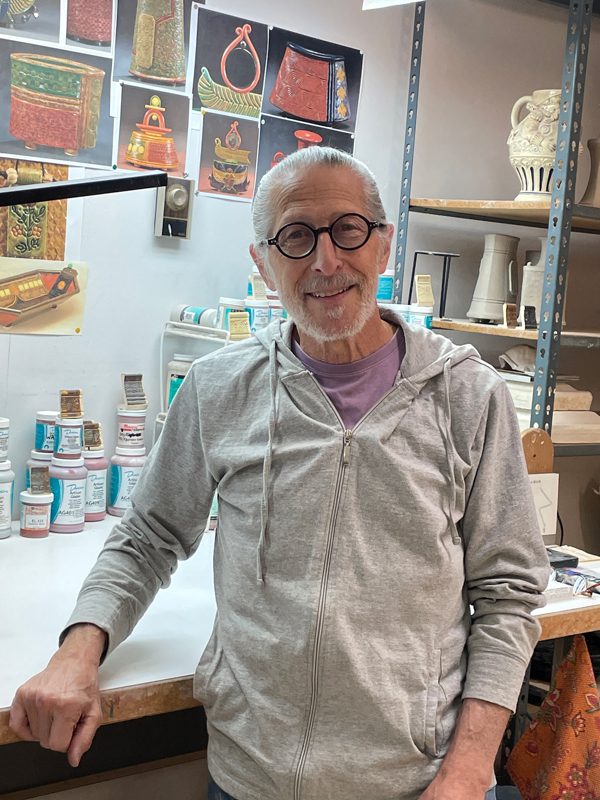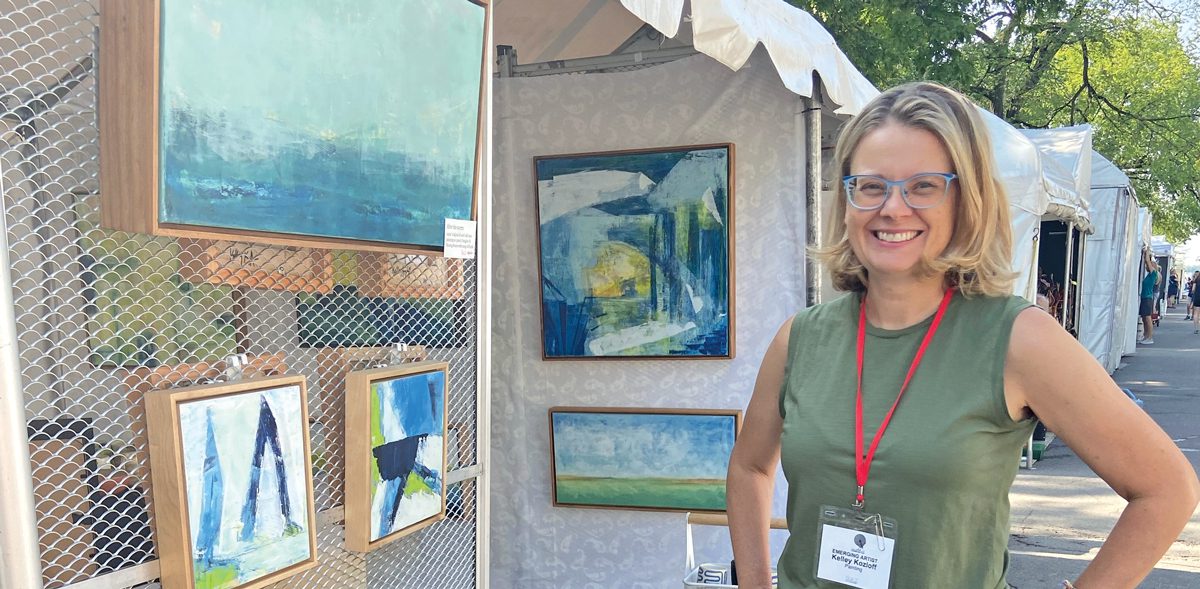Art fair artists are wildly different, but they also have a lot in common. Unlike artists who sell in brick-and-mortar galleries, they get to keep all the profits, but they also have to play all the parts—artist, dealer, booth designer, marketer, shipper, and driver.
They spend months in their studios creating their work, then long weekends on the road, driving to outdoor events anywhere from New York to California, battling the elements while setting up (and taking down) booths.
We asked four artists in this year’s Ann Arbor Art Fair why they do it, and what brought them here.

Credit: Jan Schlain
Richard Meyer
Discovering—and rediscovering—ceramics.
When Richard Meyer was fourteen, he got a part-time summer job at the La Jolla Museum of Contemporary Art. He did “things like loading and unloading the kiln” but didn’t think much of it.
He started UC San Diego as a math major, but soon realized it wasn’t for him: “I was very miserable. I was a mess.” He quit in 1974 and looked for work on the school’s job board. “There was a card that said ‘Ceramic sculptor needs hourly wage worker. No experience necessary.’ So I called him, went down to his studio and interviewed, and he hired me.”
The ceramicist “was making high-end ceramic figurines,” Meyer says, “cutesy gift-shop gifts.” But thanks to clients like Macy’s and Neiman Marcus, he was selling a ton of them and getting rich.
Meyer and two other assistants would create forms like “little round vases” that the sculptor would turn “upside down to make a head for the doll-figurine,” he recalls. But after nine months, “he came to me and said, ‘Richard, I’m going to shut my studio. I have enough money.’ But I don’t want to leave you in the lurch.”
He then walked Meyer to a nearby gallery and “introduced me to the master potter. That was Cathra-Anne Barker.
“It was 1975. I was twenty. She was thirty-two.” She warned him, “This is serious. … You are here six days a week, and you’re here at 9 a.m.” But he took the job then and there.
“At first it was, ‘Sweep the floors.’ A very basic learning curve,” Meyer says. But he’d been adrift, and the work felt “philosophically and spiritually good.”
Barker made functional stoneware. She taught him to make the pieces her customers were buying, like casserole and butter dishes. At Christmastime they turned out personalized mugs that sold so well it “was just bonkers.”
In 1980, master and apprentice started dating. In 1985, Meyer left Barker’s studio to share a space with three or four other artists, “because it was just time.” The following year, he applied to his first art fair, in Beverly Hills, “and I got accepted. That was nuts.”
He continued applying to art fairs and getting accepted. He was first admitted to the Original Ann Arbor Fair when it was still on South University. He “abandoned galleries in the late 1980s or early ’90s. It was all art fair from there on.” Barker gave up her gallery and also became an art fair artist. They married in 1991.
As he became more independent, Meyer shifted from making stoneware to raku. “Raku is singular in that when it gets to temperature, you open the kiln,” he says. He’d transfer the glowing-hot pieces to a metal barrel filled with combustible material, “and that stuff lights on fire immediately, and then you cover the chamber to starve it of oxygen. That produces smoke. The piece is bombarded by carbon. And it influences the result.”
His raku pieces sold well, but after about seven years, he says, he “started to develop a cough, even though I had been wearing protection the whole time. So I started looking at alternative firing approaches to work my way away from raku.”
Once he “began doing classic forms,” he was no longer juried into the Original. He applied to what’s now the State Street District Fair and was accepted, and he later moved to the Guild of Artists & Artisans’ State St. section.
But “people who attend the Original— not the artists but the public—think or know they are in the best fair,” Meyer says. “And so you want to be there.”
He changed the energy, the shapes, and the colors of his work, and got back into the Original in 2019. He has been showing there ever since, except for the pandemic years 2020 and 2021, when there was no fair.
The enforced layoff “was a boon for me,” Meyer says, “because I started doing these experiments in late 2019. They were really successful. Not in terms of sales, but a ninety-degree turn at least from the classic pieces. … I would look at them and say, ‘these things are good!’” Hand-thrown textured vessel forms in subtly exotic shapes and gold, green, and brown hues, they were like nothing he had ever done—and like nothing else at the fair. The pieces he’ll be bringing to Ann Arbor sell for $200–$650.
Now seventy and eighty-two, Meyer and Barker still have their own kilns, offices, and art studios in their home in Santa Fe, New Mexico. Until recently they had their own vans and schedules, too, traveling separately to about a dozen shows apiece. But “Cathra-Anne stopped driving three years ago, so I drive her,” says Meyer. “I am still involved in twelve shows a year, but only eight of them are mine.”
He’s back this year in the Original, on Washington St. in booth WA920. Barker’s shows are centered in Texas, Meyer says, because “she speaks fluent Texan, and I don’t.
“That’s one reason I’m in Ann Arbor: You figure out who your audience is.”

Courtesy of Scotty Jones
Scotty Jones
Inspired by Andy Warhol—and his grandmother’s sewing machine.
Scotty Jones always knew he wanted to be an artist. “It was just something inside me,” he says. “I didn’t know how or what I was going to do, how it was actually going to evolve.”
He grew up in the small town of Jonesboro, Indiana, in the 1960s. “In my day they would have called me hyperactive,” he says. Fortunately, his grandmother lived down the street. Even “if I was in trouble at home,” he says, “I was never in trouble at Grandma’s and Grandpa’s house.”
To keep him busy, “she would tell me how to sew on her sewing machine, which was a very old machine that had belonged to my great-grandmother, a black iron machine with Egyptian decals all over it. I was really fascinated by it.”
Then, about a decade later, “I discovered the work of Andy Warhol. He was still alive in those days, and I was kind of obsessed with him.” That led him to learn how to screen print.
Now “I practice three mediums,” says Jones, sixty-one. “I’m a digital artist, a printmaker, and a fiber artist.”
He collects photographs of people and applies collage elements and mid-century commercial art techniques to create designs that he screen prints on original textile designs and sews into wallets, handbags, and totes.
He doesn’t know most of the people whose photos he works with, but some he does. “For instance, there’s an astronaut I have that is actually my mother. And my mom was not an astronaut, but because I’m a digital artist, I can make her one.”
He went to his first art fair in 1985, when he and his partner visited his partner’s uncle, Dallas Galbraith, at a show in Indianapolis. “He’s been a member of the Guild and has been in the [Ann Arbor] show since the early 1970s,” Jones says. Seeing “the life, the world, the community, I thought, ‘this is a really interesting, fascinating thing to do.’”
If he gets into every show he’s applied to, Jones will do fourteen this year. But for him, “Ann Arbor is the show. It’s the pinnacle. People want to be there. It’s the biggest show in the country. You get to see your art friends from all over the country. It’s kind of like a big summer camp.”
This year, he’ll be back “where I always am,” in the Guild’s State St. section, booth ST432. He travels with his husband, “and he makes my work shine. … I couldn’t do it without him.”
Jones also sells “in galleries and museum gift shops,” including the Guild’s Gutman Gallery on N. Fourth Ave. “But I never meet the people who buy my work” in galleries, he says. “So they don’t get to hear that the astronaut is really my mom!”

Courtesy of Kelley Kozloff
Kelley Kozloff
From occupational therapy to painting.
Kelley Kozloff is forty-seven, and this is her first year showing and selling her paintings as a full-fledged art fair artist. A U-M kinesiology grad, she’d been working as an occupational therapist when “in the fall of 2022, I started painting.
“I took one painting class at the Ann Arbor Art Center with Beth Billups on how to use cold wax medium with oil. It’s a medium you mix with your oil paint that gives it a lot of body and allows you to create a lot of texture.
“It’s very hands-on. I get messy. And it’s very much being in the flow state.” She also enjoys exploring color, “and that’s a lot of what my work is based in.”
Kozloff’s abstracts and landscapes evoke foggy mornings on an empty beach. “I have an affinity for an uninterrupted horizon,” she says.
As a “very type-A logical person, setting my artistic side free to create the work” is the challenging part. “The rest of it is just organizing, and that’s something that comes very naturally to me.”
In 2022, she turned what had been her home office into a painting studio. “Luckily it already had a lot of natural light.” Last year, she applied to the Guild’s emerging artist program.
“Luckily they had a nice, large class that year, and I was accepted,” she says. In the program, “artists who are actively showing in art fairs and have been doing it for a while” explain everything from using social media to “how to put a tent together.”
Kozloff also was able to sell her work in one of the Guild’s shared tents for emerging artists. “That’s when I knew this is definitely what I want to pursue.”
She’ll have about twenty-five originals for sale this year, priced from $50 for small eight-by-eight-inch originals on paper to $2,800 for a framed work on canvas that’s four feet wide. She’s in the Guild’s section on Liberty, booth No. LI107.
“If you have a sweet tooth,” she says, “I’m in front of Kilwin’s.”

Courtesy of Richard Wilson
Richard Wilson
The importance of giving hope
“I’ve been drawing ever since I was about eight years old,” Richard Wilson says, making pictures of trucks and action figures for his classmates in his hometown of Robersonville, North Carolina.
His father had wanted to be an artist, but to support his family he worked as a math teacher and then as a pattern maker for a clothing company; his mother worked there too, as an inspector and trimmer.
When he was eleven, his father signed him up for art lessons by mail. By middle school, teachers “came to me and said, ‘We want you to draw these Black leaders like Martin Luther King, Harriet Tubman,’ and I did it.”
He turned in the drawings on a Friday. On Monday, “there was a bulletin board in front of the principal’s office, and it had my drawings up there. And at the top of the bulletin board it had ‘Future Artist: Richard Wilson.’
“That blew me away—just seeing that they believed in me.”
He got a degree in advertising and graphic design from Pitt Community College, then taught there. But he kept doing art, and eventually he told his wife, Wanda, “You only live once. I gotta give myself a chance to do this full time.”
He says his 2015 painting Faithful Journey symbolizes that decision. “It’s a little boy and girl walking down a railroad track. The little boy is looking back,” Wilson says. “That was my inner voice speaking to me, saying ‘Are you sure? You have three daughters, and this is a big leap of faith.’ But that weekend after I quit my job, at the first art show I did, I made more money that weekend than I did teaching for a whole year.”
Now fifty-six, Wilson will sell his pastels and prints in twelve to fifteen shows this year. In Ann Arbor, he’s in the Liberty section of the State Street District Art Fair, booth LI549-551.
He was in the Guild fair previously but wanted a change, and State Street permits artists to sell up to 250 numbered and signed prints of each piece. “You have so many people who come that can’t really afford my originals, so I want to make sure I have something for everybody,” Wilson says. Most of his originals run $1,800 to $4,500, but some he’ll bring to Ann Arbor will cost $20,000 or more. Prints start at just $60.
 His Shadow Series combines historic images and headlines about Black trailblazers like boxer Jack Johnson with foreground images of youngsters imagining themselves in their shoes—or Johnson’s boxing gloves. There’s a reproduced newspaper clipping about Johnson winning the heavyweight championship on “July 4th, 1910, and I have the date on the little boy’s gloves,” Wilson explains. “And the little boy is looking up at the punching bag because he’s dreaming big like Jack did.”
His Shadow Series combines historic images and headlines about Black trailblazers like boxer Jack Johnson with foreground images of youngsters imagining themselves in their shoes—or Johnson’s boxing gloves. There’s a reproduced newspaper clipping about Johnson winning the heavyweight championship on “July 4th, 1910, and I have the date on the little boy’s gloves,” Wilson explains. “And the little boy is looking up at the punching bag because he’s dreaming big like Jack did.”
Others pieces highlight pioneer aviator Bessie Coleman, boxer Muhammad Ali, and Civil Rights activists the Greensboro Four. “When I first started my own work, I used to see a lot of negativity for African Americans in the newspaper and on TV, and you just never saw [the] positive aspect I saw and experienced in my upbringing,” Wilson says. “And I wanted to share that with the world. I want all races to be able to see that. …
“The girls in my paintings are my daughters, and the boys are my nephews. They are my inspiration.” His family used to come with him to Ann Arbor, but when “the kids became teenagers, they didn’t want to hang with dad anymore.” This year, a friend will help him drive to Ann Arbor and set up.
At this point in his career, Wilson likely could make a nice living doing commissions. But he’s in his element at art fairs. “This is my opportunity, even though I’m not teaching anymore, to be out there to encourage people to follow their dreams,” he says. “Because I am living proof that you can make it as an artist if you just don’t give up.”
The 2024 Ann Arbor Art Fair runs July 18–20.
Hours: Thurs. & Fri., 10 a.m.–9 p.m.
Sat. 10 a.m–8 p.m.
Ann Arbor Street Art Fair, the Original
Ann Arbor State Street District Art Fair
Ann Arbor Summer Art Fair

